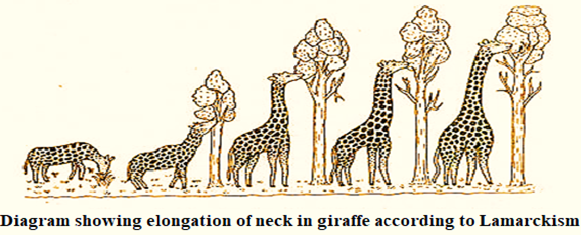
What was the basic principle of Lamarckism?
(a) Inheritance of acquired characters
(b) Natural Selection
(c) Survival of the fittest
(d) Variations
Answer
505.8k+ views
Hint: It is named after the French biologist Jean-Baptiste Lamarck and is cited against the theories of Darwinism. The principle of Lamarckism is that organisms pass down their traits to the next generation.
Complete answer:
Lamarckism is the theory that an organism can pass on its physical characteristics to its offspring that it acquired through use or disuse in its lifetime. This idea is also known as the inheritance of acquired characteristics or soft inheritance.
The most prevalent example for the theory of Lamarckism is the explanation behind the long necks of Giraffes. This is explained that as stratification began and grasses were replaced with taller trees, over generations giraffes shifted from grasses to tree leaves. This shift was facilitated by gradual lengthening of their neck to reach to the higher branches of the tree as compared to the grass or shrubs which were lower on the ground.

So, the answer is, “Inheritance of acquired characters”.
Additional Information:
It is named after the French biologist Jean-Baptiste Lamarck which is inaccurate, as he did not give this theory but used it as a supplement to his concept of orthogenesis, a drive towards complexity. Lamarckism is cited in textbooks to contrast with Darwinism.
Note: Lamarckism was a classical concept and not a contrasting theory to Darwinism. Even Darwin’s own concept of pangenesis implied soft inheritance. He accepted the use and disuse theory while rejecting the other aspects of Lamarckism. There were also many re-iterations which are collectively called “Neo-Lamarckism”.
Complete answer:
Lamarckism is the theory that an organism can pass on its physical characteristics to its offspring that it acquired through use or disuse in its lifetime. This idea is also known as the inheritance of acquired characteristics or soft inheritance.
The most prevalent example for the theory of Lamarckism is the explanation behind the long necks of Giraffes. This is explained that as stratification began and grasses were replaced with taller trees, over generations giraffes shifted from grasses to tree leaves. This shift was facilitated by gradual lengthening of their neck to reach to the higher branches of the tree as compared to the grass or shrubs which were lower on the ground.

So, the answer is, “Inheritance of acquired characters”.
Additional Information:
It is named after the French biologist Jean-Baptiste Lamarck which is inaccurate, as he did not give this theory but used it as a supplement to his concept of orthogenesis, a drive towards complexity. Lamarckism is cited in textbooks to contrast with Darwinism.
Note: Lamarckism was a classical concept and not a contrasting theory to Darwinism. Even Darwin’s own concept of pangenesis implied soft inheritance. He accepted the use and disuse theory while rejecting the other aspects of Lamarckism. There were also many re-iterations which are collectively called “Neo-Lamarckism”.
Recently Updated Pages
Master Class 11 Economics: Engaging Questions & Answers for Success

Master Class 11 Business Studies: Engaging Questions & Answers for Success

Master Class 11 Accountancy: Engaging Questions & Answers for Success

Master Class 11 English: Engaging Questions & Answers for Success

Master Class 11 Computer Science: Engaging Questions & Answers for Success

Master Class 11 Maths: Engaging Questions & Answers for Success

Trending doubts
Which one is a true fish A Jellyfish B Starfish C Dogfish class 11 biology CBSE

State and prove Bernoullis theorem class 11 physics CBSE

1 ton equals to A 100 kg B 1000 kg C 10 kg D 10000 class 11 physics CBSE

In which part of the body the blood is purified oxygenation class 11 biology CBSE

One Metric ton is equal to kg A 10000 B 1000 C 100 class 11 physics CBSE

Difference Between Prokaryotic Cells and Eukaryotic Cells




